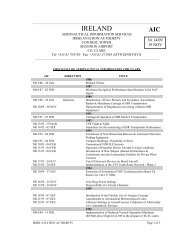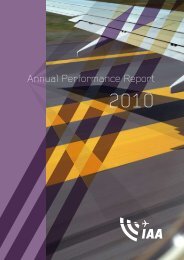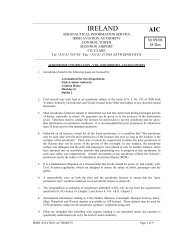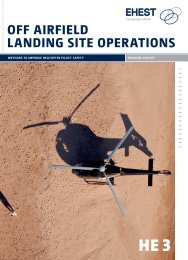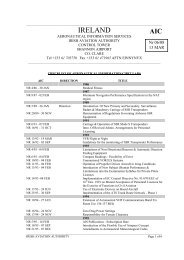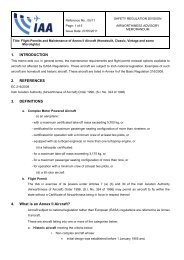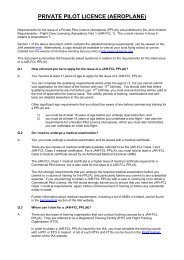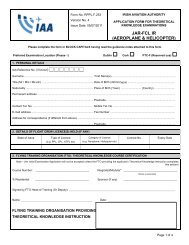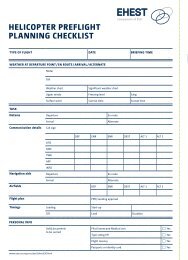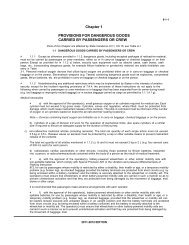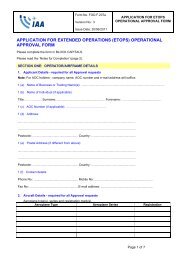Provisions for dangerous goods carried by passengers and crew
Provisions for dangerous goods carried by passengers and crew
Provisions for dangerous goods carried by passengers and crew
Create successful ePaper yourself
Turn your PDF publications into a flip-book with our unique Google optimized e-Paper software.
Part 8PROVISIONS CONCERNINGPASSENGERS AND CREW2013-2014 EDITION
8-1-1Chapter 1PROVISIONS FOR DANGEROUS GOODSCARRIED BY PASSENGERS OR CREWParts of this Chapter are affected <strong>by</strong> State Variations CH 1, US 15; see Table A-11.1 DANGEROUS GOODS CARRIED BY PASSENGERS OR CREW 1.1.1 Except as otherwise provided in 1.1.2, <strong>dangerous</strong> <strong>goods</strong>, including excepted packages of radioactive material, mustnot be <strong>carried</strong> <strong>by</strong> <strong>passengers</strong> or <strong>crew</strong> members, either as or in carry-on baggage or checked baggage or on their person.Except as provided <strong>for</strong> in Table 8-1, 30), security type equipment such as attaché cases, cash boxes, cash bags, etc.,incorporating <strong>dangerous</strong> <strong>goods</strong>, <strong>for</strong> example lithium batteries or pyrotechnic material, are totally <strong>for</strong>bidden; see entry inTable 3-1. Personal medical oxygen devices that utilize liquid oxygen are <strong>for</strong>bidden either as or in carry-on baggage or checkedbaggage or on the person. Electroshock weapons (e.g. tasers) containing <strong>dangerous</strong> <strong>goods</strong> such as explosives, compressedgases, lithium batteries, etc., are <strong>for</strong>bidden in carry-on baggage or checked baggage or on the person.1.1.2 Notwithst<strong>and</strong>ing any additional restrictions which may be implemented <strong>by</strong> States in the interests of aviation security,except <strong>for</strong> the incident reporting provisions of 7;4.4 or 7;4.5, as applicable, the provisions of these Instructions do not apply tothe following when <strong>carried</strong> <strong>by</strong> <strong>passengers</strong> or <strong>crew</strong> members or in baggage that has been separated from its owner during transit(e.g. lost baggage or improperly routed baggage) or in excess baggage <strong>carried</strong> as cargo as permitted <strong>by</strong> 1;1.1.5.1 g):1.1.3 Any organization or enterprise other than an operator (such as a travel agent), involved in the air transport of<strong>passengers</strong>, should provide <strong>passengers</strong> with in<strong>for</strong>mation about the types of <strong>dangerous</strong> <strong>goods</strong> which they are <strong>for</strong>bidden totransport aboard an aircraft. This in<strong>for</strong>mation should consist of, as a minimum, notices at those locations where there is aninterface with the <strong>passengers</strong>.1.1.4 Where provision is made <strong>for</strong> the purchase of tickets via the Internet, in<strong>for</strong>mation on the types of <strong>dangerous</strong> <strong>goods</strong>which a passenger is <strong>for</strong>bidden to transport aboard an aircraft should be provided in either text or pictorial <strong>for</strong>m <strong>and</strong> should besuch that ticket purchase cannot be completed until the passenger, or a person acting on their behalf, has indicated that theyhave understood the restrictions on <strong>dangerous</strong> <strong>goods</strong> in baggage.Table 8-1. <strong>Provisions</strong> <strong>for</strong> <strong>dangerous</strong> <strong>goods</strong> <strong>carried</strong> <strong>by</strong> <strong>passengers</strong> or <strong>crew</strong>Items or articlesMedical necessities1) Small gaseous oxygen or aircylinders required <strong>for</strong> medicaluseCheckedbaggageLocationCarry-onbaggageOn thepersonApproval of theoperator(s)is requiredThe pilot-incomm<strong>and</strong>mustbe in<strong>for</strong>medRestrictionsYes Yes Yes Yes Yes a) no more than 5 kg gross mass per cylinder;b) cylinders, valves <strong>and</strong> regulators, where fitted,must be protected from damage which couldcause inadvertent release of the contents; <strong>and</strong>c) the pilot-in-comm<strong>and</strong> must be in<strong>for</strong>med of thenumber of oxygen or air cylinders loaded onboard the aircraft <strong>and</strong> their loading location(s).Devices containing liquid oxygen No No No n/a n/a Devices containing liquid oxygen are <strong>for</strong>bidden incarry-on baggage, checked baggage or on theperson.2) Cylinders of a gas of Division 2.2worn <strong>for</strong> the operation ofmechanical limbsYes Yes Yes No No Spare cylinders of a similar size are also allowed, ifrequired, to ensure an adequate supply <strong>for</strong> theduration of the journey.2013-2014 EDITION
8-1-2 Part 8Items or articles3) Non-radioactive medicinalarticles (including aerosols)CheckedbaggageLocationCarry-onbaggageOn thepersonApproval of theoperator(s)is requiredThe pilot-incomm<strong>and</strong>mustbe in<strong>for</strong>medRestrictionsYes Yes Yes No No a) no more than 0.5 kg or 0.5 L total net quantityper single article;b) release valves on aerosols must be protected <strong>by</strong>a cap or other suitable means to preventinadvertent release of the contents; <strong>and</strong>4) Radioisotopic cardiacpacemakers or other devices,including those powered <strong>by</strong>lithium batteries implanted into apersonRadio-pharmaceuticalscontained within the body of aperson5) Mobility aids (e.g. wheelchairs)powered <strong>by</strong> non-spillable wetbatteries or batteries whichcomply with Special ProvisionA123, <strong>for</strong> use <strong>by</strong> <strong>passengers</strong>whose mobility is restricted <strong>by</strong>either a disability, their health orage, or a temporary mobilityproblem (e.g. broken leg)c) no more than 2 kg or 2 L total net quantity of allarticles mentioned in 3), 10) <strong>and</strong> 13) (e.g. fouraerosol cans of 500 mL each) per person.n/a n/a Yes No No Must be implanted into a person as the result ofmedical treatment.n/a n/a Yes No No Must be as the result of medical treatment.Yes No No Yes (see 5 d)iv))a) non-spillable wet batteries must comply withSpecial Provision A67 or the vibration <strong>and</strong>pressure differential tests of PackingInstruction 872;b) the operator must verify that:i) the battery is securely attached to themobility aid;ii)iii)the battery terminals are protected fromshort circuits (e.g. <strong>by</strong> being enclosed withina battery container); <strong>and</strong>electrical circuits have been isolated;c) mobility aids must be <strong>carried</strong> in a manner suchthat they are protected from being damaged <strong>by</strong>the movement of baggage, mail, stores or othercargo;d) where the mobility aid is specifically designed toallow its battery(ies) to be removed <strong>by</strong> the user(e.g. collapsible):i) the battery(ies) must be removed; themobility aid may then be <strong>carried</strong> as checkedbaggage without restriction;ii)iii)the removed battery(ies) must be <strong>carried</strong> instrong, rigid packagings which must bestowed in the cargo compartment;the battery(ies) must be protected fromshort circuit; <strong>and</strong>iv) the pilot-in-comm<strong>and</strong> must be in<strong>for</strong>med ofthe location of the packed battery;e) it is recommended that <strong>passengers</strong> makeadvance arrangements with each operator.2013-2014 EDITION
Chapter 1 8-1-3Items or articles6) Mobility aids (e.g. wheelchairs)powered <strong>by</strong> spillable batteries,<strong>for</strong> use <strong>by</strong> <strong>passengers</strong> whosemobility is restricted <strong>by</strong> either adisability, their health or age, ora temporary mobility problem(e.g. broken leg)CheckedbaggageLocationCarry-onbaggageOn thepersonApproval of theoperator(s)is requiredThe pilot-incomm<strong>and</strong>mustbe in<strong>for</strong>medRestrictionsYes No No Yes Yes a) where possible, the mobility aid must be loaded,stowed, secured <strong>and</strong> unloaded always in anupright position. The operator must verify that:i) the battery is securely attached to themobility aid;ii)battery terminals are protected from shortcircuits (e.g. <strong>by</strong> being enclosed within abattery container); <strong>and</strong>iii)electrical circuits have been isolated;b) if the mobility aid cannot be loaded, stowed,secured <strong>and</strong> unloaded always in an uprightposition, the battery(ies) must be removed <strong>and</strong><strong>carried</strong> in strong, rigid packagings, as follows:i) packagings must be leak-tight, imperviousto battery fluid <strong>and</strong> be protected againstupset <strong>by</strong> securing them to pallets or <strong>by</strong>securing them in cargo compartments usingappropriate means of securement (otherthan <strong>by</strong> bracing with freight or baggage)such as <strong>by</strong> the use of restraining straps,brackets or holders;ii)iii)batteries must be protected against shortcircuits, secured upright in thesepackagings <strong>and</strong> surrounded <strong>by</strong> compatibleabsorbent material sufficient to absorb theirtotal liquid contents; <strong>and</strong>these packagings must be marked “Battery,wet, with wheelchair” or “Battery, wet, withmobility aid” <strong>and</strong> be labelled with a“Corrosive” label (Figure 5-22) <strong>and</strong> withpackage orientation labels (Figure 5-26) asrequired <strong>by</strong> 5;3;The mobility aid may then be <strong>carried</strong> as checkedbaggage without restriction;c) mobility aids must be <strong>carried</strong> in a manner suchthat they are protected from being damaged <strong>by</strong>the movement of baggage, mail, stores or othercargo;d) the pilot-in-comm<strong>and</strong> must be in<strong>for</strong>med of thelocation of the mobility aid with an installedbattery or the location of a packed battery;e) it is recommended that <strong>passengers</strong> makeadvance arrangements with each operator; also,unless batteries are non-spillable they should befitted, where feasible, with spill-resistant ventcaps.2013-2014 EDITION
8-1-4 Part 8Items or articles7) Mobility aids (e.g. wheelchairs)powered <strong>by</strong> lithium ion batteries,<strong>for</strong> use <strong>by</strong> <strong>passengers</strong> whosemobility is restricted <strong>by</strong> either adisability, their health or age, ora temporary mobility problem(e.g. broken leg)CheckedbaggageYesLocationCarry-onbaggage(see7 d))On thepersonApproval of theoperator(s)is requiredThe pilot-incomm<strong>and</strong>mustbe in<strong>for</strong>medRestrictionsNo Yes Yes a) the batteries must be of a type which meets therequirements of each test in the UN Manual ofTests <strong>and</strong> Criteria, Part III, subsection 38.3;b) the operator must verify that:i) the battery is securely attached to themobility aid;ii)iii)the battery terminals are protected fromshort circuits (e.g. <strong>by</strong> being enclosed withina battery container); <strong>and</strong>electrical circuits have been isolated;c) mobility aids must be <strong>carried</strong> in a manner suchthat they are protected from being damaged <strong>by</strong>the movement of baggage, mail, stores or othercargo;d) where the mobility aid is specifically designed toallow its battery(ies) to be removed <strong>by</strong> the user(e.g. collapsible):i) the battery(ies) must be removed <strong>and</strong><strong>carried</strong> in the passenger cabin;ii)iii)the battery terminals must be protectedfrom short circuit (<strong>by</strong> insulating theterminals, e.g. <strong>by</strong> taping over exposedterminals);the battery must be protected from damage(e.g. <strong>by</strong> placing each battery in a protectivepouch);iv) removal of the battery from the mobility aidmust be per<strong>for</strong>med <strong>by</strong> following theinstructions of the manufacturer or deviceowner;v) the battery must not exceed 300 Wh; <strong>and</strong>vi) a maximum of one spare battery notexceeding 300 Wh or two spares notexceeding 160 Wh each may be <strong>carried</strong>;e) the pilot-in-comm<strong>and</strong> must be in<strong>for</strong>med of thelocation of the lithium ion battery(ies);f) it is recommended that <strong>passengers</strong> makeadvance arrangements with each operator.2013-2014 EDITION
Chapter 1 8-1-5Items or articles8) Portable medical electronicdevices (automated externaldefibrilators (AED), nebulizer,continuous positive airwaypressure (CPAP), etc.)containing lithium metal orlithium ion cells or batteriesCheckedbaggageLocationCarry-onbaggageOn thepersonApproval of theoperator(s)is requiredThe pilot-incomm<strong>and</strong>mustbe in<strong>for</strong>medRestrictionsNo Yes Yes Yes No a) <strong>carried</strong> <strong>by</strong> <strong>passengers</strong> <strong>for</strong> medical use;b) no more than two spare batteries may be<strong>carried</strong>. Spare batteries must be individuallyprotected so as to prevent short circuits (<strong>by</strong>placement in original retail packaging or <strong>by</strong>otherwise insulating terminals, e.g. <strong>by</strong> tapingover exposed terminals or placing each batteryin a separate plastic bag or protective pouch);<strong>and</strong>c) each installed or spare battery:— must be of a type which meets therequirements of each test in the UNManual of Tests <strong>and</strong> Criteria, Part III,subsection 38.3; <strong>and</strong>— must not exceed the following:— <strong>for</strong> lithium metal batteries, a lithium contentof not more than 8 grams; or9) Small medical or clinicalthermometer which containsmercuryArticles used in dressing or grooming10) Toiletry articles (includingaerosols)— <strong>for</strong> lithium ion batteries, a Watt-hour ratingof not more than 160 Wh.Yes Yes Yes No No a) no more than one per person;b) must be <strong>for</strong> personal use; <strong>and</strong>c) must be in its protective case.Yes Yes Yes No No a) the term “toiletry articles (including aerosols)” isintended to include such items as hair sprays,perfumes <strong>and</strong> colognes;b) no more than 0.5 kg or 0.5 L total net quantityper single article;c) release valves on aerosols must be protected <strong>by</strong>a cap or other suitable means to preventinadvertent release of the contents; <strong>and</strong>11) Hair curlers containinghydrocarbon gasd) no more than 2 kg or 2 L total net quantity of allarticles mentioned in 3), 10) <strong>and</strong> 13) (e.g. fouraerosol cans of 500 mL each) per person.Yes Yes Yes No No a) no more than one per person;b) the safety cover must be securely fitted over theheating element; <strong>and</strong>c) gas refills <strong>for</strong> such curlers must not be <strong>carried</strong>.2013-2014 EDITION
8-1-6 Part 8Items or articlesConsumer articles12) Alcoholic beverages containingmore than 24 per cent but notmore than 70 per cent alcohol <strong>by</strong>volumeCheckedbaggageLocationCarry-onbaggageOn thepersonApproval of theoperator(s)is requiredThe pilot-incomm<strong>and</strong>mustbe in<strong>for</strong>medRestrictionsYes Yes Yes No No a) must be in retail packagings;b) no more than 5 L per individual receptacle; <strong>and</strong>c) no more than 5 L total net quantity per person<strong>for</strong> such beverages.13) Aerosols in Division 2.2, with nosubsidiary risk, <strong>for</strong> sporting orhome use14) Securely packaged cartridges inDivision 1.4S (UN 0012 orUN 0014 only);Note.— Alcoholic beverages containing not morethan 24 per cent alcohol <strong>by</strong> volume are not subject toany restrictions.Yes No No No No a) no more than 0.5 kg or 0.5 L total net quantityper single article;b) release valves on aerosols must be protected <strong>by</strong>a cap or other suitable means to preventinadvertent release of the contents; <strong>and</strong>c) no more than 2 kg or 2 L total net quantity of allarticles mentioned in 3), 10) <strong>and</strong> 13) (e.g. fouraerosol cans of 500 mL each) per person.Yes No No Yes No a) no more than 5 kg gross mass per person <strong>for</strong>that person’s own use;b) must not include ammunition with explosive orincendiary projectiles; <strong>and</strong>c) allowances <strong>for</strong> more than one person must notbe combined into one or more packages.15) Small packet of safety matches No No Yes No No a) no more than one per person; <strong>and</strong>b) intended <strong>for</strong> use <strong>by</strong> an individual.“Strike anywhere” matches No No No n/a n/a Forbidden.Small cigarette lighter No No Yes No No a) no more than one per person;Lighter fuel <strong>and</strong> lighter refills No No No n/a n/a Forbidden.+ Premixing burner lighter (see theGlossary of Terms inAttachment 2) with a means ofprotection against unintentionalactivation+ Premixing burner lighter (see theGlossary of Terms inAttachment 2) without a meansof protection againstunintentional activationb) intended <strong>for</strong> use <strong>by</strong> an individual; <strong>and</strong>c) does not contain unabsorbed liquid fuel (otherthan liquefied gas).No No Yes No No a) no more than one per person;No No No n/a n/a Forbidden.b) intended <strong>for</strong> use <strong>by</strong> an individual; <strong>and</strong>c) does not contain unabsorbed liquid fuel (otherthan liquefied gas).2013-2014 EDITION
8-1-8 Part 8Items or articles19) Portable electronic devices (suchas watches, calculatingmachines, cameras, cellularphones, laptop computers,camcorders)Portable electronic devicescontaining lithium metal orlithium ion cells or batteriesCheckedbaggageLocationCarry-onbaggageOn thepersonApproval of theoperator(s)is requiredThe pilot-incomm<strong>and</strong>mustbe in<strong>for</strong>medRestrictionsYes Yes Yes No No a) <strong>carried</strong> <strong>by</strong> <strong>passengers</strong> or <strong>crew</strong> <strong>for</strong> personal use;b) should be <strong>carried</strong> as carry-on baggage;c) each battery must not exceed the following:— <strong>for</strong> lithium metal batteries, a lithium contentof not more than 2 grams; or— <strong>for</strong> lithium ion batteries, a Watt-hour ratingof not more than 100 Wh;+ d) if devices are <strong>carried</strong> in checked baggage,measures must be taken to prevent unintentionalactivation; <strong>and</strong>+ e) batteries <strong>and</strong> cells must be of a type whichmeets the requirements of each test in theUN Manual of Tests <strong>and</strong> Criteria, Part III,subsection 38.3.Spare batteries <strong>for</strong> portableelectronic devices containinglithium metal or lithium ion cellsor batteriesNo Yes Yes No No a) <strong>carried</strong> <strong>by</strong> <strong>passengers</strong> or <strong>crew</strong> <strong>for</strong> personal use;b) must be individually protected so as to preventshort circuits (<strong>by</strong> placement in original retailpackaging or <strong>by</strong> otherwise insulating terminals,e.g. <strong>by</strong> taping over exposed terminals or placingeach battery in a separate plastic bag orprotective pouch);c) each battery must not exceed the following:— <strong>for</strong> lithium metal batteries, a lithium contentof not more than 2 grams; or— <strong>for</strong> lithium ion batteries, a Watt-hour ratingof not more than 100 Wh; <strong>and</strong>+ d) batteries <strong>and</strong> cells must be of a type whichmeets the requirements of each test in theUN Manual of Tests <strong>and</strong> Criteria, Part III,subsection 38.3.+Portable electronic devicescontaining lithium ion batteriesexceeding a Watt-hour rating of100 Wh but not exceeding160 WhYes Yes Yes Yes No a) <strong>carried</strong> <strong>by</strong> <strong>passengers</strong> or <strong>crew</strong> <strong>for</strong> personal use;b) should be <strong>carried</strong> as carry-on baggage; <strong>and</strong>c) batteries <strong>and</strong> cells must be of a type whichmeets the requirements of each test in theUN Manual of Tests <strong>and</strong> Criteria, Part III,subsection 38.3.2013-2014 EDITION
Chapter 1 8-1-9Items or articlesSpare batteries <strong>for</strong> portableelectronic devices containinglithium ion batteries exceeding aWatt-hour rating of 100 Wh butnot exceeding 160 WhCheckedbaggageLocationCarry-onbaggageOn thepersonApproval of theoperator(s)is requiredThe pilot-incomm<strong>and</strong>mustbe in<strong>for</strong>medRestrictionsNo Yes Yes Yes No a) <strong>carried</strong> <strong>by</strong> <strong>passengers</strong> or <strong>crew</strong> <strong>for</strong> personal use;b) no more than two individually protected sparebatteries per person;c) must be individually protected so as to preventshort circuits (<strong>by</strong> placement in original retailpackaging or <strong>by</strong> otherwise insulating terminals,e.g. <strong>by</strong> taping over exposed terminals or placingeach battery in a separate plastic bag orprotective pouch); <strong>and</strong>20) Fuel cells used to power portableelectronic devices (<strong>for</strong> example,cameras, cellular phones, laptopcomputers <strong>and</strong> camcorders)d) batteries <strong>and</strong> cells must be of a type whichmeets the requirements of each test in theUN Manual of Tests <strong>and</strong> Criteria, Part III,subsection 38.3.No Yes Yes No No a) fuel cell cartridges may only contain flammableliquids, corrosive substances, liquefiedflammable gas, water reactive substances orhydrogen in metal hydride;Spare fuel cell cartridges Yes Yes Yes No Nob) refuelling of fuel cells on board an aircraft is notpermitted except that the installation of a sparecartridge is allowed;c) the maximum quantity of fuel in any fuel cell orfuel cell cartridge must not exceed:— <strong>for</strong> liquids 200 mL;— <strong>for</strong> solids 200 grams;— <strong>for</strong> liquefied gases, 120 mL <strong>for</strong> non-metallicfuel cell cartridges or 200 mL <strong>for</strong> metal fuelcell or fuel cell cartridges; <strong>and</strong>— <strong>for</strong> hydrogen in metal hydride, the fuel cellor fuel cell cartridges must have a watercapacity of 120 mL or less; d) each fuel cell <strong>and</strong> each fuel cell cartridge mustcon<strong>for</strong>m to IEC 62282-6-100 Ed. 1, <strong>and</strong> must bemarked with a manufacturer’s certification that itcon<strong>for</strong>ms to the specification. In addition, eachfuel cell cartridge must be marked with themaximum quantity <strong>and</strong> type of fuel in thecartridge;e) fuel cell cartridges containing hydrogen in metalhydride must comply with the requirements inSpecial Provision A162;f) no more than two spare fuel cell cartridges maybe <strong>carried</strong> <strong>by</strong> a passenger;g) fuel cells containing fuel are permitted in carryonbaggage only; h) interaction between fuel cells <strong>and</strong> integratedbatteries in a device must con<strong>for</strong>m toIEC 62282-6-100 Ed. 1. Fuel cells whose solefunction is to charge a battery in the device arenot permitted;2013-2014 EDITION
8-1-10 Part 8Items or articlesCheckedbaggageLocationCarry-onbaggageOn thepersonApproval of theoperator(s)is requiredThe pilot-incomm<strong>and</strong>mustbe in<strong>for</strong>medRestrictionsi) fuel cells must be of a type that will not chargebatteries when the portable electronic device isnot in use <strong>and</strong> must be durably marked <strong>by</strong> themanufacturer: “APPROVED FOR CARRIAGE INAIRCRAFT CABIN ONLY” to so indicate; <strong>and</strong>j) in addition to the languages which may berequired <strong>by</strong> the State of Origin <strong>for</strong> the markingsspecified above, English should be used.21) Dry ice Yes Yes No Yes No a) no more than 2.5 kg per person;b) used to pack perishables that are not subject tothese Instructions;c) the package must permit the release of carbondioxide gas; <strong>and</strong>d) when <strong>carried</strong> in checked baggage, eachpackage must be marked:— “DRY ICE” or “CARBON DIOXIDE,SOLID”; <strong>and</strong>22) A mercurial barometer ormercurial thermometer23) Instruments containingradioactive material (i.e.chemical agent monitor (CAM)<strong>and</strong>/or rapid alarm <strong>and</strong>identification device monitor(RAID-M))— the net weight of dry ice or an indicationthat the net weight is 2.5 kg or less.No Yes No Yes Yes a) must be <strong>carried</strong> <strong>by</strong> a representative of agovernment weather bureau or similar officialagency; <strong>and</strong>b) must be packed in a strong outer packaging,having a sealed inner liner or a bag of strongleakproof <strong>and</strong> puncture-resistant materialimpervious to mercury, which will prevent theescape of mercury from the package irrespectiveof its position.Yes Yes No Yes No a) the instruments must not exceed the activitylimits specified in Table 2-15 of theseInstructions;b) must be securely packed <strong>and</strong> without lithiumbatteries; <strong>and</strong>c) must be <strong>carried</strong> <strong>by</strong> staff members of theOrganization <strong>for</strong> the Prohibition of ChemicalWeapons (OPCW) on official travel.24) Energy efficient light bulbs Yes Yes Yes No No a) when in retail packaging; <strong>and</strong>+ 25) Permeation devices <strong>for</strong>calibrating air quality monitoringequipment+ 26) Portable electronic equipmentcontaining a non-spillable batterymeeting the requirements ofSpecial Provision A67b) intended <strong>for</strong> personal or home use.Yes No No No No Must comply with Special Provision A41.Yes Yes No No No a) the battery must not have a voltage greater than12 volts <strong>and</strong> a Watt-hour rating of not greaterthan 100 Wh; <strong>and</strong>b) the equipment must be either protected frominadvertent activation, or the batterydisconnected <strong>and</strong> exposed terminals insulated.2013-2014 EDITION
Chapter 1 8-1-11Items or articles+ Spare non-spillable batteriesmeeting the requirements ofSpecial Provision A67CheckedbaggageLocationCarry-onbaggageOn thepersonApproval of theoperator(s)is requiredThe pilot-incomm<strong>and</strong>mustbe in<strong>for</strong>medRestrictionsYes Yes No No No a) the battery must not have a voltage greater than12 volts <strong>and</strong> a Watt-hour rating of not greaterthan 100 Wh;+ 27) Internal combustion engines orfuel cell enginesb) the battery must be protected from short circuit<strong>by</strong> the effective insulation of exposed terminals;<strong>and</strong>c) no more than two individually protected batteriesper person.Yes No No No No Must comply with Special Provision A70.+ 28) Non-infectious specimens Yes Yes No No No Must comply with Special Provision A180.+ 29) Insulated packagings containingrefrigerated liquid nitrogenSecurity-type equipment30) Security-type equipment, suchas attaché cases, cash boxes,cash bags, etc., incorporating<strong>dangerous</strong> <strong>goods</strong> as part of thisequipment, <strong>for</strong> example, lithiumbatteries or pyrotechnic materialYes Yes No No No Must comply with Special Provision A152.Yes No No Yes No a) the equipment must be equipped with aneffective means of preventing accidentalactivation;b) if the equipment contains an explosive orpyrotechnic substance or an explosive article,this article or substance must be excluded fromClass 1 <strong>by</strong> the appropriate national authority ofthe State of Manufacture in compliance withPart 2;1.5.2.1;c) if the equipment contains lithium cells orbatteries, these cells or batteries must complywith the following restrictions:— <strong>for</strong> a lithium metal cell, the lithium content isnot more than 1 g;— <strong>for</strong> a lithium metal battery, the aggregatelithium content is not more than 2 g;— <strong>for</strong> lithium ion cells, the Watt-hour rating(see the Glossary of Terms inAttachment 2) is not more than 20 Wh;— <strong>for</strong> lithium ion batteries, the Watt-hour ratingis not more than 100 Wh;— each cell or battery is of the type proven tomeet the requirements of each test in theUN Manual of Tests <strong>and</strong> Criteria, Part III,subsection 38.3;d) if the equipment contains gases to expel dye orink:— only gas cartridges <strong>and</strong> receptacles, small,containing gas with a capacity notexceeding 50 mL, containing noconstituents subject to these Instructionsother than a Division 2.2 gas, are allowed;2013-2014 EDITION
8-1-12 Part 8Items or articlesCheckedbaggageLocationCarry-onbaggageOn thepersonApproval of theoperator(s)is requiredThe pilot-incomm<strong>and</strong>mustbe in<strong>for</strong>medRestrictions— the release of gas must not cause extremeannoyance or discom<strong>for</strong>t to <strong>crew</strong> membersso as to prevent the correct per<strong>for</strong>mance ofassigned duties; <strong>and</strong>— in case of accidental activation, allhazardous effects must be confined withinthe equipment <strong>and</strong> must not produceextreme noise; <strong>and</strong>e) security type equipment that is defective or thathas been damaged is <strong>for</strong>bidden <strong>for</strong> transport.___________________2013-2014 EDITION



